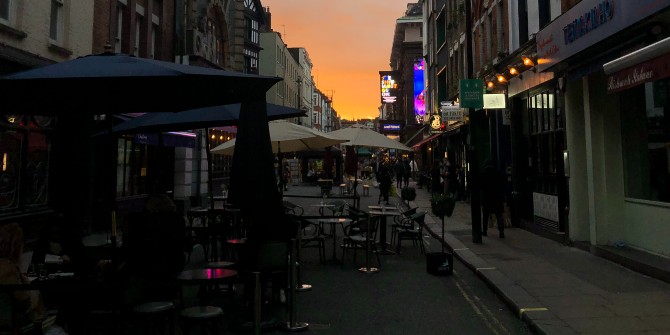COVID has become increasingly politicised in China, says Xiaobo Lü (Columbia). The zero-COVID policy is hailed as a Chinese success, and the country faces a serious challenge if it is to convince its population that another approach is possible.
There are several effects of China’s COVID response. The first is the unifying effect. Up until now, China has been able to rely on public support for its COVID policies. It has achieved that by unifying the population in a crisis, and by politicising the public health crisis. If we use a Chinese proverb to describe the situation, so far, the country has ridden the tiger; but now the challenge China faces is how to get down from a tiger’s back.
The zero-COVID policy, which used contact tracing, mass testing, isolation, quarantine and lockdown to keep the virus at bay, was successful. While some local outbreaks emerged, China never experienced a COVID wave after the first one in Wuhan. The effect was to unify the Chinese at a time of crisis. This is not unique to China — in times of crisis, such as wars and pandemics, society tends to rally round government policies — but the successful control of large-scale outbreaks of the virus in China means that people generally trust and accept government policy. That fact has given the policies a much easier time. A couple of years ago, some people in China were concerned about privacy issues as a result of widely usage of mobile apps and surveillance, but using technology to control the pandemic has enhanced the acceptance of this kind of surveillance.
The politicisation of the COVID response had its origins in the pressure from the Trump administration to investigate and trace the origins of COVID, which Trump named the “China virus”. China reacted by effectively saying that if the US was going to politicise the issue, so would China. One of the forms this takes is the use of Chinese traditional medicine to treat COVID. Regardless of the lack of scientific evidence, it is regarded as part of the toolkit. Another is the insistence on surface transmission of the coronavirus: COVID is said to have arrived in China through seafood in the cold chain. Since China has the most restrictive zero-COVID policies, the argument goes, the virus must have entered the country from outside, on a surface.
Scientists who try to interpret what living with COVID would look like encounter resistance and online attacks, because the zero-COVID policy has been such a success
A third element of this politicisation is that fewer Chinese scientists are able to speak up on the pandemic and its response. At the start of the pandemic, they communicated with the public, among other things, about the importance of vaccination. Now their voices have become weaker. Scientists who try to interpret what living with COVID would look like encounter resistance and online attacks, because the zero-COVID policy has been such a success. The country lacks a vibrant scientific debate on how to get back to normal.
The second is the isolation effect. While it has largely kept domestic society open, China has retained very strict international travel restrictions. This has hurt some sectors badly. Ordinarily, in the fourth week of January, China would have had 10,000 scheduled flights. In January 2022, it was just 500. While international civil aviation has bounced back from the pandemic, China is an exception. By creating a zero-COVID bubble, it feels as though China is – at least metaphysically – further away from the rest of the world. At the Beijing Winter Olympics, for example, some international major media outlets sent reporters to cover the Games, and they entered a secure Olympic bubble. Yet, journalists who stationed in Beijing already could not report on the Games because they were outside of the bubble. One international correspondent with NBC, Keir Simmons, who is a Briton, covered some stories on China leading up to the Winter Olympics without actually being there, which is an odd phenomenon.
The concept of ‘living with COVID’ is a hot potato in China
We do not know when and how China will implement a COVID exit strategy. The concept of ‘living with COVID’ is a hot potato in China. Unlike in the West, where countries have planned their strategies some time ahead, there is no timeline in China. China has rarely done that throughout the pandemic, and people do not expect it either. Essentially, this is a public policy challenge created by the country’s own success in tackling the virus. The framing of the problem is crucial, and right now the government is not communicating as actively as it should about how to ‘get down from the tiger’s back’. Other countries are starting to regard COVID as endemic, but in China that terminology is both novel and foreign.

Similarly, when the vaccine booster programme was launched, the government used a very technical term — xuguan — to describe it. But vaccination touches everyone, so you have to use language that everyone can understand, which is hunda — or use a different vaccine as a booster. Chinese leaders will also have to decide whether to approve BioNTech mRNA vaccines. On Chinese social media, I already see an element of pandemic fatigue and loss of trust beginning to kick in, but authorities are wary of diverging from the official line. Recently an official media outlet posted a Weibo clip of a health official speaking at a press conference about the 483 infections at the Winter Olympics, saying that no one was hospitalised or died and they all self-recovered. But soon the post was deleted, even though it came from official TV. Perhaps so many people had commented under that post that the official outlet felt the need to self-censor on this sensitive subject.
When a crisis lasts this long, the campaigning style may not work so well
The Chinese Communist Party is accustomed to achieving its goals in a campaigning style. In dealing with a public health crisis like the pandemic, this style may be an advantage because it has a huge impact and enables them to mobilise resources. This approach worked in the first wave, and it was not unique to China: Boris Johnson also invoked a ‘war on COVID’. But when a crisis lasts this long, the campaigning style may not work so well. In the longer term, a much more institutionalised system that can quickly decide, for example, who pays for the vaccine rollout and COVID tests and treatments. In China, it took some time in late 2020 to decide who should pay for them and eventually decided to pay out of health insurance, rather than through local government finance. Comparing that with the US, a federal system, which shouldered the costs of all vaccination programme, it is striking to note that a unitary system like China’s actually had to take time to decide who should pay for the COVID vaccination programme.
This post represents the views of the author and not those of the COVID-19 blog, nor LSE. It is based on Xiaobo Lü’s contribution to China and the World in the Post-COVID Era: a new agenda of public policy, an event to celebrate the launch of the LSE-Fudan Global Public Policy Hub.





